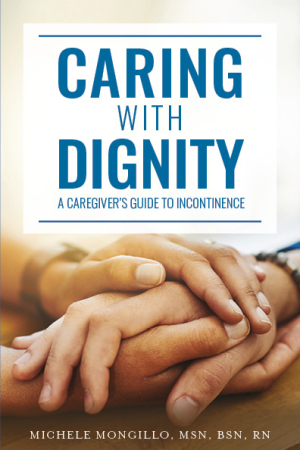Caring with Dignity
A Caregiver's Guide to Incontinence
Defining incontinence in concise terms alongside guidance for recognizing the signs of the problem, Caring with Dignity is a straightforward medical reference text.
Michele Mongillo’s caregiver’s resource Caring with Dignity offers support to those who take care of incontinent people.
Each chapter begins with an anecdote about dealing with incontinence and includes exchanges between those with the issue and their family members and friends who want to help. All follow a similar trajectory: The person with incontinence or their caregiver names the issue, and people work toward solutions together. The direct but kind language in these exchanges makes them useful as templates for addressing a sensitive issue.
Still, the scripts are quite generic. They appear sans personalizing and humanizing details, and stock photographs are used to embellish them. They are short and generalized, and their resolutions are uniformly upbeat. Situations that do not end well are not represented, and this intentional optimism is, ironically, not altogether reassuring as a result.
Indeed, the book is more effective as a medical resource than it is at modeling situations. It defines the types of incontinence in concise terms and includes guidance for recognizing the signs of the problem. Self-care tips, lists of medical interventions and products, and spreadsheets to fill out are also incorporated. And as it aims to be applicable in a wide range of situations and in the contexts of handling the issue for children with special needs, elderly people, and terminally ill people, the text adopts a holistic tone, and its advice extends beyond physical support to include emotional support tips too.
The book’s layout also makes it useful as a fast reference. Its headings appear in bold text, and it numbers its chapter-ending takeaway points for ease of location. There are tips for cleaning soiled furniture, clothes, and skin, as well as worksheets for listing dietary intake and routines in order to anticipate and prevent problems. But beyond its useful glossary, list of websites and services, and checklists, it includes hazy illustrations that add little. Further, the product guide excludes all brands but one, and the spreadsheet covering when to use what type of their products is repetitive of earlier information. Indeed, this overt endorsement of a single product is disruptive to the overall mission of shifting “from hidden conversations to open discussions” about incontinence, making the book read more as an advertisement than a resource in places.
A generalized resource for those assisting others through tough medical situations, Caring with Dignity models discussing incontinence in a sensitive manner.
Reviewed by
Mari Carlson
Disclosure: This article is not an endorsement, but a review. The publisher of this book provided free copies of the book and paid a small fee to have their book reviewed by a professional reviewer. Foreword Reviews and Clarion Reviews make no guarantee that the publisher will receive a positive review. Foreword Magazine, Inc. is disclosing this in accordance with the Federal Trade Commission’s 16 CFR, Part 255.

